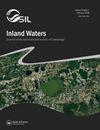基于卫星遥感数据的简单单变量方法对湖泊蓝藻和有害藻华的近期预测
IF 2.3
3区 环境科学与生态学
Q1 LIMNOLOGY
引用次数: 2
摘要
对湖泊中蓝藻和有害藻华(HABs)的近期预测对于减少对人类和动物健康以及水处理的风险至关重要。蓝藻预测模型通常是复杂的,需要输入生物物理和化学测量或原位DNA测序。卫星图像提供了一个独特的机会,以低成本和广泛的空间和长时间尺度直接估计蓝藻浓度。本研究探讨了一种假设,即简单的单变量预测方法可以可靠地预测卫星遥感检测到的近期(提前1周)蓝藻华。基于移动平均和季节分量的逻辑分解,建立了一个简单的单变量模型,利用空间聚合的卫星遥感数据预测湖泊蓝藻和藻华的叶绿素A浓度。一个由15个空间分布的水体组成的小测试集使用一年的时间序列来评估1周、2周和4周预测水平的预测性能。在一周的时间范围内,蓝藻繁殖对健康造成的高风险的预测准确率可以达到80%。2周和4周的预测准确率分别降至71%和69%。预测效果受湖泊大小的影响较弱,表明空间聚集方法对大型湖泊也是有效的。此外,较长的时间序列减少了观测到的预报误差,这可能是由于较好的季节特征。该研究首次证明了基于遥感时间序列的简单单变量模型可以预测蓝藻和赤潮,其可靠性与复杂模型几乎相同。本文章由计算机程序翻译,如有差异,请以英文原文为准。
Near-term forecasting of cyanobacteria and harmful algal blooms in lakes using simple univariate methods with satellite remote sensing data
Near-term forecasting of cyanobacteria and harmful algal blooms (HABs) in lakes is essential to reduce risks to human and animal health and water treatment. Cyanobacteria forecasting models are typically complex, requiring input of biophysical and chemical measurements or DNA sequencing in situ. Satellite imagery presents a unique opportunity to estimate cyanobacteria concentration directly at low cost and over wide spatial and long timescales. This study explores the hypothesis that simple univariate forecasting methods can reliably forecast cyanobacterial blooms in the near-term (1 week ahead) detected using satellite remote sensing. A simple univariate model based on logical decomposition with a moving average and seasonal component was developed to forecast chlorophyll a concentrations from cyanobacteria and algal blooms in lakes using spatially aggregated satellite remotely sensed data. A small test set of 15 spatially distributed waterbodies was used to assess forecast performance on 1-week, 2-week, and 4-week forecast horizons using a year-long hold-out time series. For a 1-week time horizon, cyanobacterial blooms posing a high health risk could be forecast with 80% accuracy. The 2-week and 4-week forecast accuracy dropped to 71% and 69%, respectively. Forecast performance was only weakly influenced by lake size, suggesting that the spatial-aggregation approach may be valid even for large lakes. Additionally, longer time series reduced the observed forecast error, presumably because of better seasonal characterization. This study is the first to demonstrate that simple univariate models with remotely sensed time series can forecast cyanobacteria and HABs with almost the same reliability as complex models.
求助全文
通过发布文献求助,成功后即可免费获取论文全文。
去求助
来源期刊

Inland Waters
LIMNOLOGY-MARINE & FRESHWATER BIOLOGY
CiteScore
6.10
自引率
9.70%
发文量
34
审稿时长
>12 weeks
期刊介绍:
Inland Waters is the peer-reviewed, scholarly outlet for original papers that advance science within the framework of the International Society of Limnology (SIL). The journal promotes understanding of inland aquatic ecosystems and their management. Subject matter parallels the content of SIL Congresses, and submissions based on presentations are encouraged.
All aspects of physical, chemical, and biological limnology are appropriate, as are papers on applied and regional limnology. The journal also aims to publish articles resulting from plenary lectures presented at SIL Congresses and occasional synthesis articles, as well as issues dedicated to a particular theme, specific water body, or aquatic ecosystem in a geographical area. Publication in the journal is not restricted to SIL members.
 求助内容:
求助内容: 应助结果提醒方式:
应助结果提醒方式:


